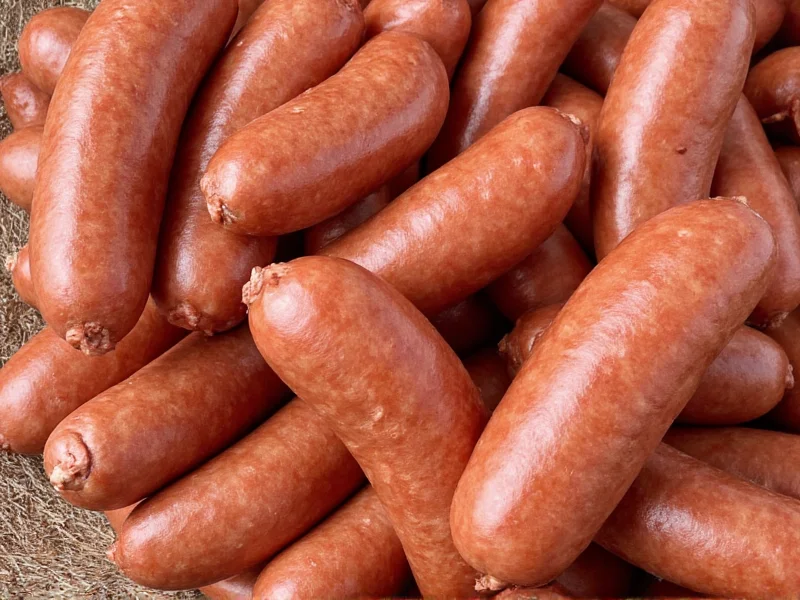Understanding sausage nomenclature reveals centuries of culinary tradition. The names we use for different sausages aren't arbitrary—they reflect geographical origins, key ingredients, preparation methods, and cultural significance. This comprehensive guide explores the fascinating world of sausage terminology across continents, helping you identify and appreciate these beloved meat products beyond their basic definition.
Why Sausage Names Matter
Sausage naming conventions serve as culinary fingerprints that identify regional specialties. When you understand what traditional european sausage varieties like Merguez or Loukaniko signify, you gain insight into their spice profiles, cooking methods, and cultural contexts. These names aren't just labels—they're windows into food history and regional identity.
Regional Sausage Classification
Sausages can be categorized by preparation method, with fresh, smoked, dried, and cooked varieties representing different preservation techniques developed throughout history. The historical origins of sausage names often reflect these methods—'salami' derives from the Italian 'salare' (to salt), indicating its salt-cured nature.
| Region | Signature Sausages | Key Characteristics | Traditional Pairings |
|---|---|---|---|
| Germany | Bratwurst, Weisswurst, Blutwurst | Pork/beef base, subtle spices, often boiled then grilled | Sauerkraut, potato salad, sweet mustard |
| Italy | Soppressata, Mortadella, Luganega | Coarse grind, wine-infused, dried or fresh | Antipasto platters, crusty bread, aged cheeses |
| Spain | Chorizo, Morcilla, Fuet | Paprika-heavy, smoked or fresh, often garlic-forward | Tapas plates, beans, roasted vegetables |
| Eastern Europe | Kielbasa, Kabanos, Blood Sausage | Garlic-intensive, smoked, often with marjoram | Sauerkraut, boiled potatoes, rye bread |
| Middle East/N. Africa | Merguez, Sucuk, Harissa sausage | Spicy, lamb-based, heavily spiced with cumin/chili | Couscous, flatbreads, grilled vegetables |
Decoding Sausage Terminology
Many international sausage terminology terms describe preparation methods rather than specific recipes. 'Frankfurter' indicates origin from Frankfurt, while 'kielbasa' simply means 'sausage' in Polish. Understanding these linguistic clues helps decipher menu items and grocery selections. Terms like 'fresh,' 'smoked,' 'dried,' and 'cured' provide essential preparation information that affects both flavor and cooking requirements.
European Sausage Traditions
Germany's authentic german sausage types number over 1,500 varieties, with regional specialties like Nürnberger Rostbratwurst (small, spiced pork sausages) protected by EU geographical indication. Italy's different kinds of italian sausages often feature regional wine and herbs, with Tuscany's finocchiona highlighting fennel seeds. Spain's chorizo varieties range from mild sweet paprika versions in the north to fiery hot varieties in the south, demonstrating how regional sausage naming conventions reflect local taste preferences.
American Adaptations
In the United States, sausage naming often reflects immigrant influences. 'Breakfast sausage' typically refers to seasoned ground pork patties, while 'hot dogs' represent Americanized frankfurters. Regional specialties like Louisiana's andouille (with its distinctive smoked flavor) and New England's red hot (a bright red, finely ground sausage) showcase how regional meat preparation techniques evolve in new cultural contexts. The term 'Italian sausage' in American markets usually denotes fennel-seasoned pork sausage, differing from Italy's more varied regional interpretations.
Identifying Quality Sausages
When selecting sausages, examine ingredient lists for quality indicators. Authentic varieties typically contain meat, fat, salt, spices, and natural casings—with minimal fillers or preservatives. Traditional European sausages often list only regional ingredients without artificial additives. Understanding sausage name meanings helps identify genuine products versus generic imitations that might use the name without adhering to traditional preparation methods.
Global Sausage Evolution
Modern culinary trends have sparked creative sausage innovations while preserving traditional naming conventions. Artisanal producers now craft fusion varieties like 'kimchi chorizo' or 'miso kielbasa,' yet maintain respect for original naming traditions. This evolution demonstrates how sausage nomenclature history continues to influence contemporary food culture while adapting to new palates and ingredients.
What's the difference between salami and pepperoni?
Salami refers to a broad category of fermented, air-dried sausages with hundreds of regional varieties across Europe. Pepperoni is a specific American-Italian variety of salami, typically spicier with a finer grind, made from pork and beef with paprika and chili pepper. While all pepperoni is salami, not all salami is pepperoni.
Why are some sausages called 'blood sausage'?
Blood sausages incorporate animal blood (usually pork) as a primary ingredient, which gives them their distinctive dark color and rich, iron-rich flavor. Known as 'morcilla' in Spain, 'blutwurst' in Germany, and 'kaszanka' in Poland, these sausages represent traditional nose-to-tail eating practices where no part of the animal goes to waste.
How can I identify authentic regional sausages?
Look for protected designation of origin (PDO) labels for European sausages, which guarantee authentic production methods. Check ingredient lists for regional spices and preparation terms. Authentic German bratwurst won't contain fillers like breadcrumbs, while genuine Spanish chorizo specifies 'pimentón' (smoked paprika) rather than generic 'paprika.' Local butchers specializing in regional cuisines typically offer the most authentic varieties.
What makes a sausage 'fresh' versus 'cured'?
Fresh sausages require refrigeration and cooking before consumption (like Italian sausage or bratwurst). Cured sausages undergo preservation through salt, smoke, or fermentation, making them safe to eat without cooking (like salami or pepperoni). The curing process develops distinctive flavors and textures while extending shelf life significantly compared to fresh varieties.
Why do sausage names vary so much between countries?
Sausage nomenclature reflects centuries of regional development, with names often describing preparation methods, key ingredients, or places of origin. Cultural preferences influenced spice blends and meat selections, while language differences created distinct naming traditions. Many terms evolved from local dialects and historical contexts, resulting in the rich diversity of sausage names we see today across different culinary traditions.











 浙公网安备
33010002000092号
浙公网安备
33010002000092号 浙B2-20120091-4
浙B2-20120091-4